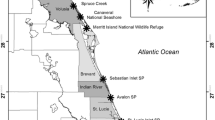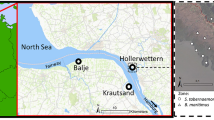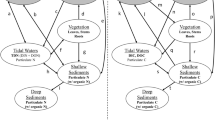Abstract
Wetlands are highly productive ecosystems that can sequester large quantities of carbon. However, variation in physiological potential can alter their capacity to sequester carbon. To examine variation in ecosystem physiological capacity, we established three coastal marsh sites in Mississippi and Alabama spanning a productivity gradient. Over 1 year, we measured ecophysiological activity and spectral indices in two vegetation zones within each marsh to develop a better understanding of variation in ecosystem responses and health. Gross ecosystem exchange of carbon and ecosystem respiration rates (Reco) differed significantly among sites, with the highest activity at Grand Bay, Mississippi and Point Aux Pines, Alabama and lower ecophysiological activity at Dauphin Island, Alabama. Net ecosystem exchange was similar for all three study areas because greater carbon assimilation was negated by higher levels of respiration. Spectral indices and leaf area were significantly different by marsh vegetation zone, suggesting that alterations in species composition and plant productivity can have important implications for carbon sequestration. While limited to 1 year, this study establishes a foundation by which to evaluate future research conducted over greater temporal and spatial scales, thereby enhancing our understanding of marsh physiological activity.






Similar content being viewed by others
References
Altor AE, Mitsch WJ (2008) Pulsing hydrology, methane emissions and carbon dioxide fluxes in created marshes: a 2-year ecosystem study. Wetlands 28:423–438
Anderson CJ, Mitsch WJ (2005) Effect of pulsing on macrophyte productivity and nutrient uptake: a wetland mesocosm experiment. Am Midl Nat 154:305–319
Barbier EB, Hacker SD, Kennedy C, Koch EW, Stier AC, Silliman BR (2011) The value of estuarine and coastal ecosystem services. Ecol Monogr 81:169–193
Battaglia LL, Woodrey MM, Peterson, Dillon KS, Visser JM (2012) In: Batzer DP, Baldwin AH (eds) Wetlands of the Northern Gulf Coast in Wetland Habitats of North America: Ecology and Conservation Issues. University of California Press, Berkeley
Boelman NT, Stielglitz M, Rueth HM, Sommerkorn M, Griffin KL, Shaver GR, Gamon JA (2003) Response of NDVI, biomass, and ecosystem gas exchange to long-term warming and fertilization in wet sedge tundra. Oecologia 135:414–421
Burrows EH, Bubier JL, Mosedale A, Cobb GW, Crill PM (2005) Net ecosystem exchange of carbon dioxide in a temperate poor fen: a comparison of automated and manual chamber techniques. Biogeochemistry 76:21–45
Chmura GL (2011) What do we need to assess the sustainability of the tidal salt marsh carbon sink? Ocean Coast Manage. https://doi.org/10.1016/j.ocecoaman.2011.09.006
Chmura GL, Anisfeld SC, Cahoon DR, Lynch JC (2003) Global carbon sequestration in tidal, saline wetland soils. Glob Biogeochem Cycles. https://doi.org/10.1029/2002GB001917
Cornell JA, Craft CB, Megonigal JP (2007) Ecosystem gas exchange across a created salt marsh chronosequence. Wetlands 27(2):240–250
Duarte CM, Middelburg JJ, Caraco N (2005) Major role of marine vegetation on the oceanic carbon cycle. Biogeosciences 2:1–8
Duarte CM, Kennedy H, Marbà N, Hendriks I (2011) Assessing the capacity of seagrass meadows for carbon burial: current limitations and future strategies. Ocean Coast Manage. https://doi.org/10.1016/j.ocecoaman.2011.09.001
Ehleringer JR, Monson RK (1993) Evolutionary and ecological aspects of photosynthetic pathway variation. Annu Rev Ecol Syst 24:411–439
Gamon JA, Peñuelas J, Field CB (1992) A narrow-waveband spectral index that tracks diurnal changes in photosynthetic efficiency. Remote Sens Environ 4:35–44
Gamon JA, Serrano L, Surfus JS (1997) The photochemical reflectance index: an optical indicator of photosynthetic radiation use efficiency across species, functional types, and nutrient levels. Oecologia 112:492–500
Gattuso JP, Frankignoulle M, Wollast R (1998) Carbon and carbonate metabolism in coastal aquatic ecosystems. Annu Rev Ecol Evol Syst 29:405–434
Harris A, Gamon JA, Pastorello GZ, Wong CYS (2014) Retrieval of the photochemical reflectance index for assessing xanthophyll cycle activity: a comparison of near-surface optical sensors. Biogeosciences 11:6277–6292
Hopkinson CS, Cai W, Hu X (2012) Carbon sequestration in wetland dominated coastal systems-a global sink of rapidly diminishing magnitude. Curr Opin Environ Sustain 4:186–194
IPCC (2014) Climate change 2014: the physical science basis. Contribution of working group I to the fifth assessment report of the intergovernmental panel on climate change. Cambridge University Press, Cambridge, UK, and New York
Jimenez KL, Starr G, Staudhammer CL, Schedlbauer JL, Loescher HW, Oberbauer SF (2012) Carbon dioxide exchange rates from short- and long-hydroperiod Everglades freshwater marsh. J Geophys Res Biogeosci. https://doi.org/10.1029/2012JG002117
Kathilankal JC, Mozdzer TJ, Fuentes JD, D’Odorico P, McGlathery KJ, Zieman JC (2008) Tidal influences on carbon assimilation by a salt marsh. Environ Res Lett 3:044010
Kearney MS, Stutzer D, Turpie K, Stevenson JC (2009) The effects of tidal inundation on the reflectance characteristics of coastal marsh vegetation. J Coast Res 25:1177–1186
Kinyanjui M (2010) NDVI-based vegetation monitoring in Mau forest complex, Kenya. Afr J Ecol 49:165–174
La Puma IP, Philippi TE, Oberbauer SF (2007) Relating NDVI to ecosystem CO2 exchange patterns in response to season length and soil warming manipulation in arctic Alaska. Remote Sens Environ 109:225–236
Leuning R, Cleugh HA, Zegelin SJ, Hughes D (2005) Carbon and water fluxes over a temperate Eucalyptus forest and a tropical wet/dry savanna in Australia: measurements and comparison with MODIS remote sensing estimates. Agric For Meteorol 129:151–173
Littell RC, Milliken GA, Stroup WW, Wolfinger RD, Schabenberger O (2006) SAS for mixed models, 2nd edn. SAS Institute Inc., Cary
Mcleod E, Chmura GL, Bouillon S, Salm R, Björk M, Duarte CM, Lovelock CE, Schlesinger WH, Stillman BR (2011) A blueprint for blue carbon: toward an improved understanding of the role of vegetated coastal habitats in sequestering CO2. Front Ecol Environ 9:552–560
Mishra DR, Cho HJ, Ghosh S, Fox A, Downs C, Merani PBT, Kirui P, Jackson N, Mishra S (2012) Post-spill state of the marsh: remote estimation of the ecological impact of the Gulf of Mexico oil spill on Louisiana Salt Marshes. Remote Sens Environ 118:176–185
Mitsch J, Gosselink JG (2000) The value of wetlands: importance of scale and landscape setting. Ecol Econ 35:25–33
Mitsch WJ, Gosselink JG (2007) Wetlands, 4th edn. John Wiley & Sons Inc, New York
Morris JT (2007) Estimating net primary production of salt marsh macrophytes. In: Fahey TJ, Knapp AK (eds) Principles and standards for measuring primary production. Oxford University Press, New York, pp 106–119
Naumann JC, Anderson JE, Young DR (2008) Linking physiological responses, chlorophyll fluorescence and hyperspectral imagery to detect salinity stress using the physiological reflectance index in the coastal shrub, Myrica cerifera. Remote Sens Environ 112:3865–3875
Oberbauer SF, Starr G, Pop EW (1998) Effects of extended growing season and soil warming on carbon dioxide and methane exchange of tussock tundra in Alaska. J Geophys Res 103:29075–29082
Odum EP, Birch JB, Cooley JL (1983) Comparison of giant cutgrass productivity in tidal and impounded marshes with special reference to tidal subsidy and waste assimilation. Estuaries 6(2):88–94
Odum WE, Odum EP, Odum HT (1995) Nature’s pulsing paradigm. Estuaries 18(4):547–555
Ollinger SV (2010) Sources of variability in canopy reflectance and the convergent properties of plants. New Phy 189:375–394
Pendleton L, Donato DC, Murray BC, Crooks S, Jenkins WA, Sifleet S, Craft C, Fourqurean JW, Kauffman JB, Marbà N, Megonigal P, Pidgeon E, Herr D, Gordon D, Baldera A (2012) Estimating global “Blue Carbon” emissions from conversion and degradation of vegetated coastal ecosystems. PLoS ONE. https://doi.org/10.1371/journal.pone.0043542
Pennings SC, Grant MB, Bertness MD (2005) Plant zonation in low-latitude salt marshes: disentangling the roles of flooding, salinity and competition. J Ecol 93:159–167
Peñuelas J, Piñol J, Filella I (1997) Estimation of plant water concentration by the reflectance water index WI (R900/R970). Int J Remote Sens 18:2869–2875
Rasse DP, Peresta G, Drake BG (2005) Seventeen years of elevated CO2 exposure in a Chesapeake Bay wetland: sustained but contrasting responses of plant growth and CO2 uptake. Glob Change Biol 11:369–377
Rocha AV, Goulden ML (2009) Why is marsh productivity so high? New insights from eddy covariance and biomass measurements in a Typha marsh. Agric For Meteorol 149:159–168
Schedlbauer JL, Oberbauer SF, Starr GS, Jimenez KL (2010) Seasonal differences in the CO2 exchange of a short-hydroperiod Florida Everglades marsh. Agric For Meteorol 150:994–1006
Schedlbauer JL, Munyon JW, Oberbauer SF, Gaiser EE, Starr G (2012) Controls on ecosystem carbon dioxide exchange in short- and long-hydroperiod Florida Everglades freshwater marshes. Wetlands 32:801–812
Schulze ED, Beck E, Müller-Hohenstein K (2005) Plant ecology. Springer, Berlin
Silliman BR, van de Koppel J, McCoy MW, Diller J, Kasozi GN, Earl K, Adams PN, Zimmerman AR (2012) Degradation and resilience in Louisiana salt marshes after the BP–Deepwater Horizon oil spill. PNAS 109(28):11234–11239
Sims DA, Gamon JA (2003) Estimation of vegetation water content and photosynthetic tissue area from spectral reflectance: a comparison of indices based on liquid water and chlorophyll absorption features. Remote Sens Environ 84:526–537
Sklar FH, Browder JA (1998) Coastal environmental impacts brought about by alterations to freshwater flow in the Gulf of Mexico. Environ Manage 22:547–562
Stout JP (1984) The ecology of irregularly flooded salt marshes of the northeastern Gulf of Mexico: a community profile. Department of the Interior, Fish and Wildlife Services, Washington, DC
Teal JM, Kanwisher J (1961) Gas exchange in a Georgia salt marsh. Limnol Oceanogr 6:388–393
Thibodeaux LJ, Valsaraj KT, John VT, Papadopoulos KD, Pratt LR, Pesika NS (2011) Marine oil fate: knowledge gaps, basic research, and development needs, A perspective based on the deepwater Horizon Spill. Environ Eng Sci 28:87–93
Touchette BW, Smith GA, Rhodes KL, Poole M (2009) Tolerance and avoidance: two contrasting physiological responses to salt stress in mature marsh halophytes Juncus roemerianus Scheele and Spartina alterniflora Loisel. J Exp Mar Biol Ecol 380:106–112
Turner RE (1990) Landscape development and coastal wetland losses in the Northern Gulf of Mexico. Am Zool 89:89–105
Wang M, Guan D, Han S, Wu J (2009) Comparison of eddy covariance and chamber-based methods for measuring CO2 flux in a temperate mixed forest. Tree Physiol 30:149–163
Waring RH, Landsberg JJ, Williams M (1998) Net primary production of forests: a constant fraction of gross primary production? Tree Physiol 18:129–134
Wiegert RG, Freeman BJ (1990) Tidal marshes of the southeast Atlantic Coast: a community profile. Department of the Interior, Fish and Wildlife Services, Washington, DC
Wilson BJ, Mortazavi B, Kiene RP (2015) Spatial and temporal variability in carbon dioxide and methane exchange at three coastal marshes along a salinity gradient in a northern Gulf of Mexico estuary. Biogeochemistry 123:329–347
Yan Y, Zhao B, Chen J, Guo H, Gu Y, Wu Q, Li B (2008) Closing the carbon budget of estuarine wetlands with tower-based measurements and MODIS time series. Glob Change Biol 14:1–13
Zhang Y, Li C, Trettin CC, Li H, Sun G (2002) An integrated model of soil, hydrology, and vegetation for carbon dynamics in wetland ecosystems. Global Biogeochem Cycles 16(4):1–17
Acknowledgements
The authors would like to thank Jay McIlwain and the professional staff at Grand Bay National Estuarine Research Reserve who dedicated time and resources to this project. Furthermore, we would like to thank field volunteers Phillip Jarnigan, Cathy Jarnigan, Betsy Jarnigan, Wesley Jarnigan, Nicholas Sanders, Joshua Jones and Catherine Rice.
Funding
Support for this project was provided by the Marine Environmental Science Consortium BP Global Reporting Initiative grant T1-002-UA.
Author information
Authors and Affiliations
Corresponding author
Rights and permissions
About this article
Cite this article
Starr, G., Jarnigan, J.R., Staudhammer, C.L. et al. Variation in ecosystem carbon dynamics of saltwater marshes in the northern Gulf of Mexico. Wetlands Ecol Manage 26, 581–596 (2018). https://doi.org/10.1007/s11273-018-9593-z
Received:
Accepted:
Published:
Issue Date:
DOI: https://doi.org/10.1007/s11273-018-9593-z




